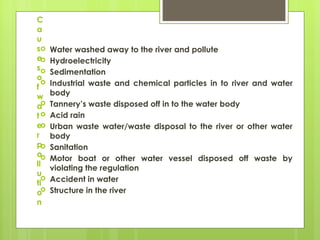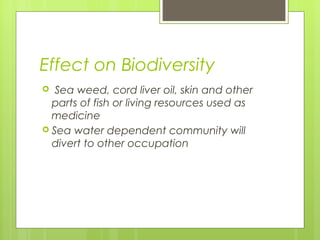water pollution
- 1. Water Pollution Prepared by Lt Cdr Shoboocktagin
- 2. Introduction Water pollution is the contamination of water bodies, usually as a result of human activities. Water bodies include for example lakes, rivers, oceans, aquifers and groundwater. Water pollution results when contaminants are introduced into the natural environment. For example, releasing inadequately treated wastewater into natural water bodies can lead to degradation of aquatic ecosystems. In turn, this can lead to public health problems for people living downstream. They may use the same polluted river water for drinking or bathing or irrigation. Water pollution is the leading worldwide cause of death and disease, e.g. due to water-borne diseases.
- 3. Types Surface water pollution: Surface water pollution includes pollution of rivers, lakes and oceans. A subset of surface water pollution is marine pollution. Marine pollution: One common path of entry by contaminants to the sea are rivers. An example is directly discharging sewage and industrial waste into the ocean. Pollution such as this occurs particularly in developing nations. In fact, the 10 largest emitters of oceanic plastic pollution worldwide are, from the most to the least, China, Indonesia, Philippines, Vietnam, Sri Lanka, Thailand, Egypt, Malaysia, Nigeria, and Bangladesh. Groundwater pollution: Interactions between groundwater and surface water are complex. Consequently, groundwater pollution, also referred to as groundwater contamination, is not as easily classified as surface water pollution. By its very nature, groundwater aquifers are susceptible to contamination from sources that may not directly affect surface water bodies.
- 4. Water washed away to the river and pollute Hydroelectricity Sedimentation Industrial waste and chemical particles in to river and water body Tannery’s waste disposed off in to the water body Acid rain Urban waste water/waste disposal to the river or other water body Sanitation Motor boat or other water vessel disposed off waste by violating the regulation Accident in water Structure in the river C a u s e s o f w a t e r p o ll u ti o n
- 6. Effect of water pollution Dependence on ground water for irrigation as a result agricultural production reduced Surface water reduced Natural resource from water reduced. Such as fish. Navigable water reduced Water tourism Dumping in the ocean by waste disposal, cargo waste disposal Atomic waste disposal in the ocean by developed country
- 7. Effect on Biodiversity Sea weed, cord liver oil, skin and other parts of fish or living resources used as medicine Sea water dependent community will divert to other occupation
- 8. Measures to control Pollution Through enforcement Through motivation or building awareness in global and national level








